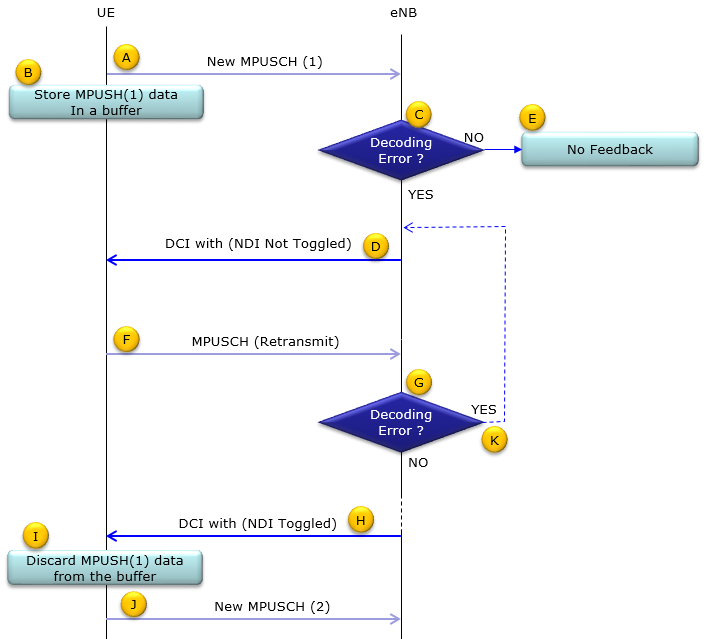|
HARQ
In short, HARQ mechanism for LTE M1 downlink is similar to legacy LTE mechanism (except the repetitive transmission), but HARQ mechanism is a little bit different from legacy LTE as described below.
HARQ Operation for Downlink
HARQ Process for Downlink is similar to legacy LTE except that each transmission would happen in repetition in LTE-M1. The rough HARQ sequence would be as follows.
i) UE <-- NW : MPDCCH (DCI for PDCCH) in repetition
ii) UE <-- NW : PDSCH in repetition
iii) UE --> NW : HARQ ACK/NACK
Note : Step i) and ii) happens not in the same subframe. (This is different from legacy LTE)
Following is what is commented in 3GPP
36.321 - 5.3.2.1 HARQ entity describes as follows
- For NB-IoT UEs or BL UEs or UEs in enhanced coverage, the parameter DL_REPETITION_NUMBER provides the number of transmissions repeated in a bundle. For each bundle, DL_REPETITION_NUMBER is set to a value provided by lower layers. Within a bundle, after the initial (re)transmission, DL_REPETITION_NUMBER-1 HARQ retransmissions follow. The HARQ feedback is transmitted for the bundle and a downlink assignment corresponding to a new transmission or a retransmission of the bundle is received after the last repetition of the bundle. A retransmission of a bundle is also a bundle.
HARQ Operation for Uplink
HARQ Process for Downlink of M1 is similar to legacy LTE except that each transmission would happen in repetition. However, HARQ Process for Uplink in M1 is different from legacy LTE. The most critical difference is that eNB does not send any HARQ ACK/NACK for PUSCH (It is understandable because there is no PHICH in LTE M1). Then, you may ask how eNB can handle the case where PUSCH reception fail ? Following process would give you the answer.
The rough HARQ sequence would be as follows.
i) UE <-- NW : MPDCCH (DCI for PUSCH) with UL Grant in repetition
ii) UE --> NW : PUSCH in repetition
iii) One of the following cases happens :
- case 1 : NW successfully decoded PUSCH, it stops there and complete PUSCH reception process.(No ACK transmission).
- case 2 : NW failed to decode PUSCH. it sends MPDCCH (DCI for PUSCH) for PUSCH retransmission
NOTE : If UE does not receive MPDCCH for PUSCH retransmission, UE assumes that PUSCH is properly received by NW. PHICH does not exists to send ACK/NACK for PUSCH in LTE M1.

36.321 - 5.4.2.1 HARQ entity, 5.4.2.2 HARQ process, 7.7 HARQ RTT Timers describes as follows
- Uplink HARQ operation is asynchronous for NB-IoT UEs, BL UEs or UEs in enhanced coverage except for the repetitions within a bundle.
- For NB-IoT UEs, BL UEs or UEs in enhanced coverage, the parameter UL_REPETITION_NUMBER provides the number of transmission repetitions within a bundle. For each bundle, UL_REPETITION_NUMBER is set to a value provided by lower layers. Bundling operation relies on the HARQ entity for invoking the same HARQ process for each transmission that is part of the same bundle. Within a bundle HARQ retransmissions are non-adaptive and are triggered without waiting for feedback from previous transmissions according to UL_REPETITION_NUMBER. An uplink grant corresponding to a new transmission or a retransmission of the bundle is only received after the last repetition of the bundle. A retransmission of a bundle is also a bundle.
- For NB-IoT UEs, BL UEs or UEs in enhanced coverage for UL_REPETITION_NUMBER for Mode B operation, the same redundancy version is used multiple times before cycling to the next redundancy version as specified in Subclause 16.5.1.2, 8.6.1 and 7.1.7.1 in 36.213.
- For BL UEs and UEs in enhanced coverage, HARQ RTT Timer corresponds to 7 + N where N is the used PUCCH repetition factor, where only valid (configured) UL subframes as configured by upper layers in fdd-UplinkSubframeBitmapBR are counted. In case of TDD, HARQ RTT Timer corresponds to 3 + k + N, where k is the interval between the last repetition of downlink transmission and the first repetition of the transmission of associated HARQ
feedback, and N is the used PUCCH repetition factor, where only valid UL subframes are counted as indicated in subclauses 10.1 and 10.2 of 36.213
RV Determination : PDSCH for SystemInformationBlockType1-BR
SystemInformationBlockType1-BR is retransmitted and each retransmission uses different RV (Redundancy Version). RV for each retransmission varies depending on SystemInformationBlockType1-BR retransmission patter as described below : (Refer to 36.321 - 5.3.1 DL Assignment reception for further details)
RV = ceiling(3/2*k) mod 4 // k is determined depending of the number of repetitions
Case 1 : number of repetitions for PDSCH carrying SystemInformationBlockType1-BR is 4
Case 2 : number of repetitions for PDSCH carrying SystemInformationBlockType1-BR is 8
Case 3 : number of repetitions for PDSCH carrying SystemInformationBlockType1-BR is 16
k = (SFN * 10 + i) mod 4 , where i = subframe number in the SFN
Reference
[1] 3GPP TS 36.321 V13.2.0 (2016-06)
[2]
|
